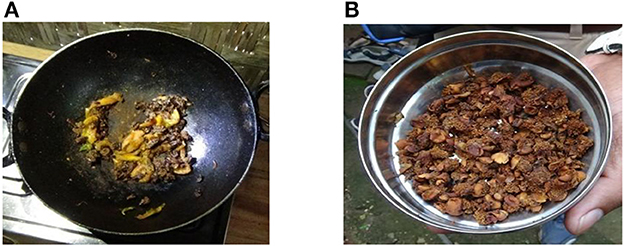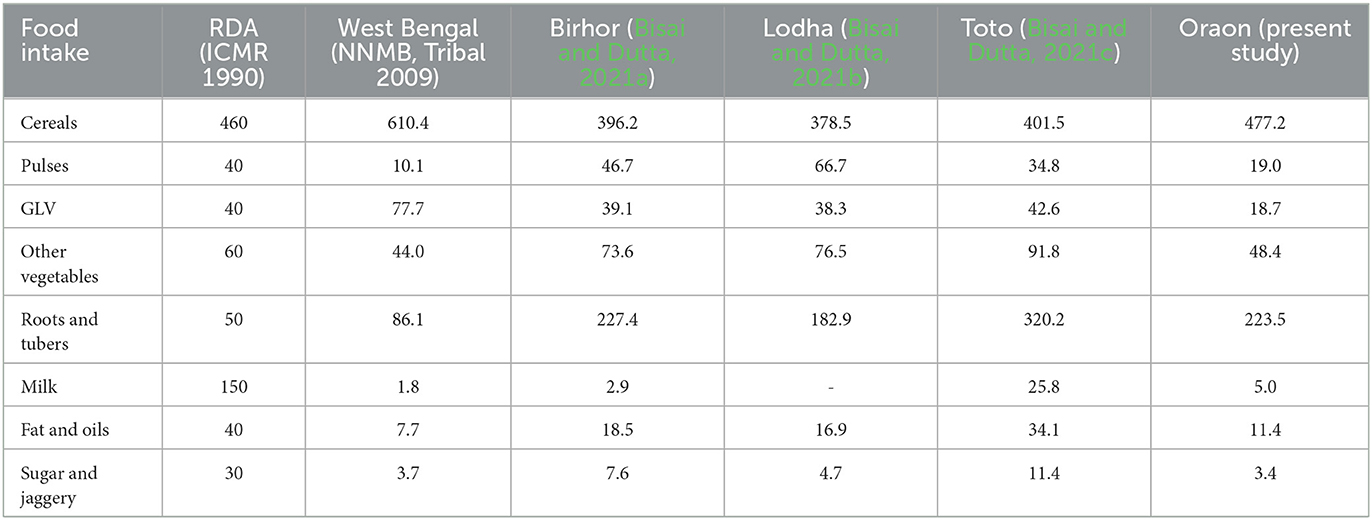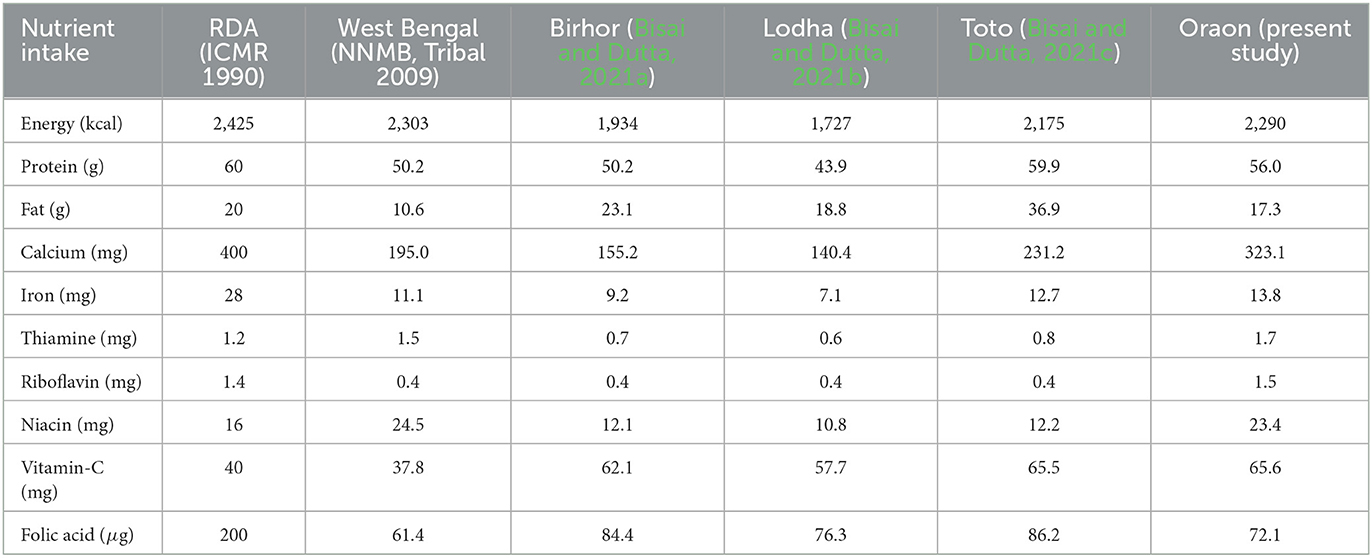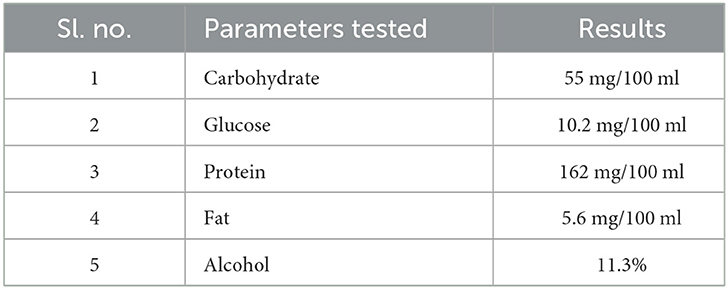- 1Public Health and Nutrition Research Unit, Department of Anthropology and Tribal Studies, Sidho-Kanho-Birsha University, Purulia, West Bengal, India
- 2Cultural Research Institute, Kolkata, West Bengal, India
- 3Department of Microbiology, Raiganj University, Raiganj, West Bengal, India
Introduction: Food consumption is an intensive social activity and can be considered a cultural artifact, reflecting the intricate process of sociocultural differentiation in shaping eating habits. Food has a positive effect on a person's health, physical performance, and state of mind. The nutritional composition of a person's diet plays a significant role in their overall health and development. Moreover, tribal cuisine is incomplete without a traditional drink. Rice beer, or handia, is one such indigenous alcoholic-fermented beverage that serves as a staple food.
Methods: This exploratory cross-sectional study was conducted from January, 2018 to December, 2020 to explore the traditional food practices of the Oraon community through a combination of one-to-one interviews, focus group discussions, and measurements. This study also involved the documentation of individual food recipes, from collection to preparation. To assess nutrient intake, we used a 24-h dietary recall method for 200 Oraon families comprising 466 adults and 193 children. Anthropometric measurements, such as body mass index (BMI) for adults and height-for-age and BMI-for-age z-score methods for children, recommended by the WHO, were taken and recorded using standard procedures. Additionally, the nutrient content of handia was analyzed.
Results: The mean (SD) height, weight, mid-upper arm circumference (MUAC), and BMI of the Oraon people were analyzed. The combined overall prevalence of chronic energy deficiency (CED) (BMI < 18.5 kg/m2) was 39% (37% in men and 40.3% in women). The prevalence of overweight and obesity (BMI ≥ 25.0 kg/m2) was found to be 7.1% among only women. The average daily energy intake was calculated to be 2,290 kcal per capita. It is worth noting that the food and nutrient consumption of the Oraon tribe was largely consistent with the recommended daily allowances/intakes (RDA/RDI). The consumption of root and tuber products was particularly high. The Oraon tribe was found to have a familiar intake of animal protein in the form of meat, including common periwinkles (Littorina littorea). The study also discovered a remarkable array of unique, region-specific festive foods. The consumption of nutrient-rich fermented rice beer was especially noteworthy.
Conclusion: The present study provides insight into the traditional food practices of the Oraon tribe in West Bengal. It also highlights that their indigenous food consumption patterns have undergone significant changes as a result of admixture with other communities. To address these dietary issues, it is recommended that regional, need-based planning, and effective intervention programs be implemented. To ensure the proper maintenance of the Oraon tribe's traditional food practices, the cultivation of kitchen gardens and the domestication of wild, edible plants, such as seeds and tubers, may be helpful. Moreover, promoting the consumption of macronutrient-fortified handia, an indigenous beverage with high medicinal benefits, could be effective in combating hidden hunger among adults.
Introduction
Food consumption is an intensive social activity and can be considered a cultural artifact, reflecting the intricate process of sociocultural differentiation in shaping eating habits. Food has a positive effect on a person's health, physical performance, and state of mind. The nutritional composition of a person's diet plays a significant role in their overall health and development. When all nutrients are consumed in the appropriate proportion required by the body, it is known as “good” or “optimum” nutrition, which helps to maintain good health.
However, malnutrition, that is, undernourishment, micronutrient deficiencies, and obesity, is a result of an ongoing nutrition transition and poses a significant threat to public health (Pinstrup-Andersen, 2007; von Grebmer et al., 2014). Thus, studying food and eating habits is important as food plays a fundamental role in human survival.
Tribal communities are closely connected to nature and its resources, and this connection is reflected in their simple and respectful approach to food.
The same reverence is reflected in their cuisine; tribal communities consider their food sacred. Tribal cuisine is not only interesting but also nutritious and well-balanced. Tribal food systems are an integral part of their cultural heritage and traditions. Food is an important part of their identity and culture. It reflects the geography to which they belong and the locally available resources used in their cuisine.
The dietary patterns of the tribes in India living in various regions and agro-climatic conditions may vary greatly due to their secluded lifestyles, food habits, dietary practices, and attitudes toward food. Beliefs, customs, and traditions influence the general pattern of living in any community. It is well known that the geological composition of the soil determines the occurrence of local flora, cropping patterns, and the associated agricultural practices in a given area. Knowledge of the food resources available to humans has been crucial in allowing them to survive in adverse conditions.
As per the 2011 census, the total scheduled tribes in India make up 8.6% of the country's total population. The census records 705 different tribes, with 75 of them designated as particularly vulnerable tribal groups (PVTGs). West Bengal is the 9th-most highly populated state in India by tribes, accounting for 5.1% of the country's tribal population. Approximately 5.8% of the state's total population of 9.13 crores includes scheduled tribes (Bisai et al., 2014). In West Bengal, the total population of the Oraon tribe is 643,510, of which 322,933 are men and 320,577 are women. The sex ratio of the Oraon community is 993 women per 1,000 men. The literacy rate in the Oraon community is 59.0%. This rate is higher for men, at 68.1%, compared to that of women, which is 49.9% (Dutta and Bisai, 2020). The population of Oraon people has grown by 4.27% in the decade between 2001 and 2011. The Oraon tribe is a Dravidian-speaking agricultural community from Chhota Nagpur. They have their own language, Kurukh, and follow strict marriage customs that involve clan exogamy and tribe endogamy. The Oraon tribe practices strict exogamy within their clans and endogamy within the tribe. They have a rich cultural heritage and a multitude of exogamous septs such as Ikka, Minz, Kujur, Bura, Turkey, Beck, Khess, Bandh, Bakura, Bahula, Khakha, Tigga, Toppo, Lakra, Bakhla, Bando, Bara, Barwa or Khoea, Kerketta, Khalko, Kindo, Kispota, Munjini, Pana, and Runda, each with a unique totem that serves as a symbol of identity and is considered taboo by its members. With the aim of preserving the flavors of ingredients, they cook with very few spices and consume food that is mostly raw, semi-cooked, roasted, or fermented. Additionally, many members of the Oraon tribe have diversified into other occupations, including trade and commerce, and some have taken up professional jobs. However, agriculture remains a significant part of their livelihood and is deeply intertwined with their cultural identity. They consume non-vegetarian diet. Rice is their staple food, while mutton, fowl, fish, and eggs are eaten with great pleasure. They also consume some locally available pulses, green leafy vegetables, and vegetables with rice. Tea has gained popularity as a beverage. Haria (in Bengali) or Handia (in Hindi) plays an important role in its consumption in everyday life and on different occasions. Handia is prepared from parboiled rice and a mixture of fermented inoculums called Ranu or Bakhor. Geographical variations may create a distinction in the nutritional value of this fermented brew. In view of the above, the present study was undertaken to examine the impact of traditional food patterns on the nutritional health of the Oraon tribe, the second-largest tribal community in West Bengal, India.
Materials and methods
This exploratory cross-sectional study was conducted in six districts of West Bengal: Birbhum, Dakshin Dinajpur, Jalpaiguri (undivided), North 24 Parganas, Purulia, and Paschim Medinipur. The tribal villages in these districts were strategically selected based on their high concentration of Oraon communities, as well as their diverse geographical settlements and variations. This study aimed to document the role of indigenous foods in promoting good nutrition and balanced eating habits among the Oraon tribal community in West Bengal. Fieldwork for this study was carried out from January, 2018 to December, 2020. To accurately compare the CED between men and women in the studied community, the minimum sample size was calculated using a standard formula:
The prevalence of CED among men and women was 47% and 31%, respectively (Mittal and Srivastava, 2006). With a 95% confidence interval and 80% power, a minimum estimated sample size was 146 from each group. Therefore, a total of 200 households were selected through a simple random sampling method for food analysis and assessment of nutritional status. Anthropometric data were collected from 466 adults (men = 203 and women = 233) and 193 children. Informed consent was obtained from all the participants before data collection. All data were collected by trained investigators.
Primary data on commonly consumed Indigenous food items were collected through interviews with a pre-validated questionnaire and focus group discussions. The questionnaire underwent a pilot survey before the main study was conducted to ensure its accuracy and effectiveness (Bisai and Dutta, 2021a). These data were used to assess the extent of food options available to the Oraon community and evaluate the significance of wild, indigenous foods in their regular diets. The 24-h dietary recall method was used to collect data on food and nutrient consumption. The tribal households were contacted through their respective district administrations. Most of the respondents were homemakers with extensive knowledge and experience in food preparation techniques. All recipes were collected through audio-visual methods while the female member of the household was cooking food.
The food item information was recorded by its most common English name, its availability during certain seasons, and how it was consumed. The items were grouped together based on their edible part, providing an organized description. The nutritional value of each food item was determined using the method outlined by Gopalan et al. (1989).
The total carbohydrate content of handia was determined using the Anthrone method (Yemm and Willis, 1954). The level of glucose was estimated using the standard biochemical method: the DNS method (Lv et al., 2021). Protein content was estimated using Lowry's method (Ledoux and Lamy, 1986). Moreover, fat content was quantified using the standard extraction-titration method (Frankel and Tarassuk, 1955). The level of alcohol was determined according to the colorimetric method described by Sumbhate et al. (2012). All the chemicals used in this experiment—Anthrone, DNS, Folin–Ciocalteu reagent, and others—were of analytical grade and purchased from Himedia and SRL in India. Distilled water was used in all the experiments. The instruments used in the study were a microprocessor-based UV-VIS double-beam spectrophotometer (model LI-2700) and a μP photocolorimeter (S. No. 17010015), both of which were purchased from Haryana, India.
Anthropometric characteristics such as height, weight, and mid-upper arm circumference (MUAC) were measured using standard methods (Lohman et al., 1988). The research personnel underwent comprehensive training to ensure accurate measurement techniques were used as part of the multi-pass strategy. Adult nutritional status was assessed using the BMI cutoffs recognized internationally (WHO., 1995). The children's nutritional status was evaluated using height-for-age and body mass index-for-age z-scores, calculated using the WHO Anthro-Plus software. Stunting and thinness were classified as Z-score values less than the −2 standard deviation of the reference median. All statistical analyses were performed using SPSS and MedCalc software. A p-value of < 0.05 was considered statistically significant.
Results
The food practices of indigenous communities, such as the Oraon tribe, are characterized by their rich cultural traditions and the utilization of locally available resources and techniques. The population under study also displays their unique dietary patterns in various geographical locations. While the food values of many indigenous foods, such as plants, insects, and fungi, have been explored (DeFoliart, 1992; Boa, 2004; Kuhnlein et al., 2009; Rathode, 2009), there is still a lack of research on the nutrient intake pattern of the tribes in India. The present study aimed to explore the food habits of the Oraon tribal community, particularly with respect to their varied geographical habitat, use of, nutritional value, and traditional knowledge of indigenous foods.
A list of commonly consumed food items by the Oraons is presented in Table 1. The dietary practices of the Oraon community, which resides in a diverse ecological area, are mentioned in the following text. Data on the recipes were gathered from the interviews and recorded as part of the documentation process.
The Oraon community of the Purulia district cohabits with other communities, leading to significant changes in their eating habits. Rice is the staple food for the Oraon community. They generally obtain vegetables from nearby markets. Due to the rocky terrain of the adjacent hills, they are unable to collect any wild food. They only collect the jeerhol flower in March and April and consume it on the day of their nabanna festival. They eat khichdi on the day of their Sarul puja, a seasonal festival. The Oraon tribe residing in Paschim Medinipur has a history of migration from the Chhota Nagpur region dating back several generations. They refer to themselves as the heirs of those who helped Lord Rama fight Ravana. They celebrate Goyal puja (worshiping the cowshed) in Kartik (from October to November). They prepare a special dish made from Dhoan moong dal (yellow lentils) and chicken that has been offered as a sacrifice at the cowshed. On the same day, they prepare a dish called khichdi with rice and biri dal, which they offer to the cow after worshiping it (except for pregnant cows). During the Agrahan–Poush months (November to January), when the new harvest is brought into their homes, they celebrate the nabanna festival with different types of pitha (rice cake), especially mangshopitha (made from rice powder and chicken) (Figure 1A). On the last day of Poush month (mid-January), they celebrate Poush Sankranti. They make poushkush or pooshladdu with rice powder and fill them with coconut crumbs, sesame, ginger, jaggery, or sugar. On the occasion of Rash Purnima in the Kartik–Agrahan (November) month, they make gur pithas (Figure 1B), which they distribute to their relatives. While visiting the nearby forest in the rainy season, if found, they collect Kham aalu, Kurkuri Chhatu, Bon kundri, cashew nuts, and yams. They consume handia daily, including at festivals. The Oraon tribe residing in the Birbhum district reveres “Nagpur-Dhanpur” as their chief god, which they worship in the Chhota Nagpur region of Jharkhand. The Oraon community receives a letter each year listing the names of those who are required to attend a yearly pilgrimage to the Chhota Nagpur region of Jharkhand. During this pilgrimage, it is mandatory for participants to wear traditional clothing and speak in their mother tongue, Kurukh, also known as Thaar Bhasa. Each clan has its own puja, called the Basanti Puja, which takes place every 10 years. During the year when the Basanti Puja is held, no marriages are arranged within that particular year. They sacrifice four kinds of animals for this puja: boroboli, mejoboli, sejoboli, and chhotoboli. A fully grown-up buffalo with large horns is sacrificed as boroboli. A pig is sacrificed as mejoboli. A male goat is sacrificed as sejoboli, and a hen is sacrificed as chhotoboli. They observe a 24-h long fast, which they break with bhog made from rice and a sacrificed hen (Figure 1C). While celebrating the Karam puja in the Bhadra month (from August to September), they offer three hens of different colors as a sacrifice. The meat is then cooked with rice without the use of any oil. The red hen, or khayer, and the tamakatu hen are consumed by the male members of the village, while the white hen is consumed by the female members of the village. The head and leg portions are reserved for the elders, referred to as morobbi. On the occasion of Poushsankranti, they prepare various types of pitha (Figure 1A), including a rice cake made with kalokolai paste. On the day of poilaMagh (mid-January), they celebrate their Shalgram puja, during which they prepare askepithe (Figure 1D) using rice powder and jaggery. They cook it in an earthen pot. It is customary that postpartum mothers do not receive any cooked food after giving birth. They are allowed to eat only muri (puffed rice) or chiwda and drink lukewarm water. For up to 21 days after delivery, they can only have boiled food without any spices or oil once a day. Consumption of meat, fish, eggs, or fruits is strictly prohibited during this postpartum pollution period. After the Nokhna ceremony, on the 21st day after childbirth, the mother is allowed to enter the kitchen and resume her normal diet. The consumption of Paatsaak (jute leaves) and periwinkles (a species of small edible whelks) is a common dietary habit among the Oraons community of Dakshin Dinajpur (Figures 2A–E). They celebrate Ashari Maayer Pujo in the month of Ashar (from June to July) with the belief that it will bring prosperity through rainfall. The ritual of Dandakatta holds significance in this festival. The Oraon people perform it before any ceremony or to purify the house. The main occupation of the Oraon people residing in the Jalpaiguri and Alipurduar districts is tea gardening. The main issue with the Oraon people in this region is that most families adopted Christianity as their religion due to the inclusion of missionaries. Thus, they have undergone many cultural changes. Food patterns have also changed. Only the consumption of tea flowers could be found among them, which solely depends on availability (Figure 3A). They preserve it for longer use (Figure 3B). It tastes bitter and is cooked with tomatoes and other vegetables. The Oraon tribe in the North 24 Parganas district of West Bengal has adapted the tropical climate of mangrove area in this delta region. They cook the shalukful (water lily), bunoamra (wild mombins), and keora fruit. They catch rodents and cook them with different spices.
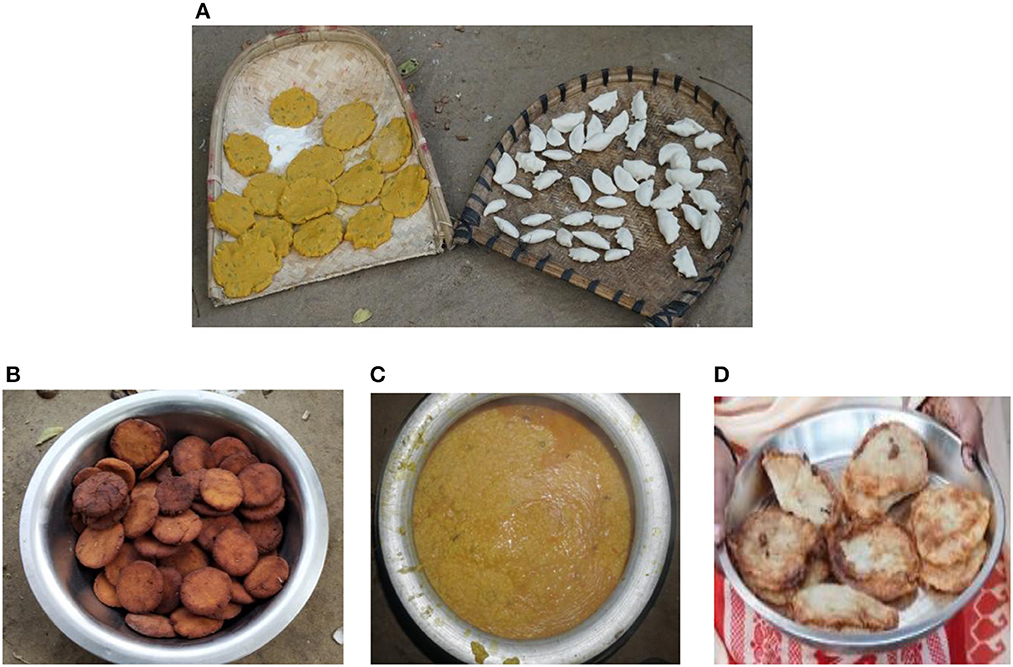
Figure 1. Festive foods: (A) Different types of pitha (cake). (B) Gur-pitha. (C) Bhog is made for god. (D) Aske-pitha.
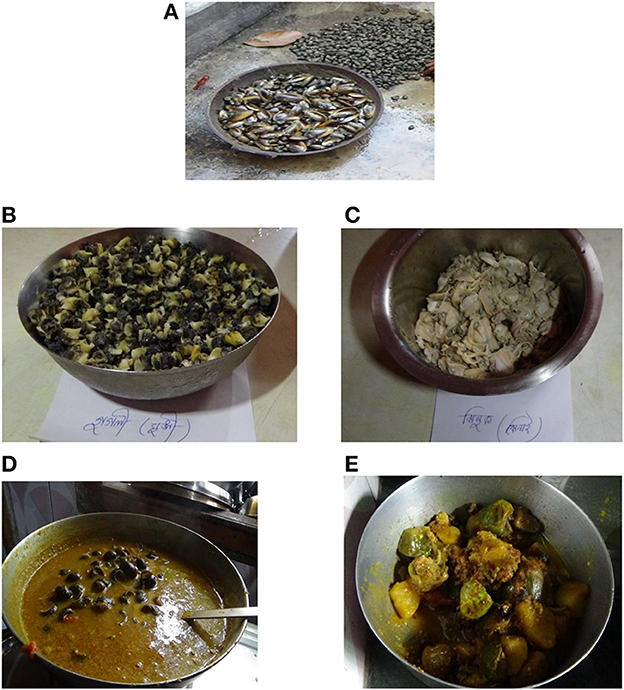
Figure 2. Protein rich foods: (A) The Ghungi (Common Periwinkles). (B, C) Meat of periwinkles. (D, E) Common periwinkles being cooked in a different way.
Table 2 summarizes the anthropometric characteristics expressed as the mean and standard deviation of weight, height, MUAC, and BMI of adult Oraon men and women. As expected, mean weight, height, and MUAC were significantly higher among men than women. The nutritional status of the adult Oraons of West Bengal is presented in Table 3. The overall prevalence of CED and overweight/obesity was 39% (men: 37% and women: 40.3%) and 7%, respectively. It was observed that the prevalence of CED and overweight/obesity among Oraon women is higher than that among men. Moreover, the prevalence of stunting and thinness (CED) among children aged under 18 years was found to be 34.2 and 32.6%, respectively.
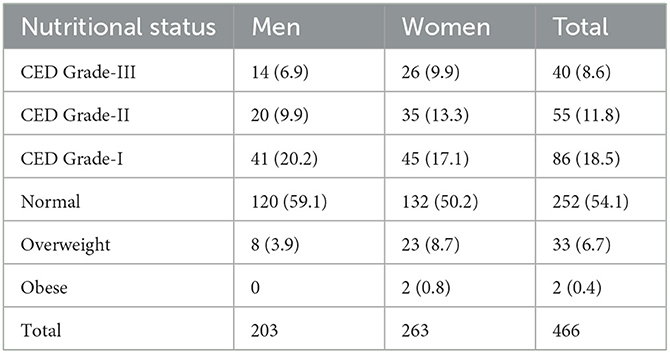
Table 3. Nutritional status based on BMI (WHO., 1995) of adult Oraons of West Bengal.
It was revealed that handia consumption improves the nutritional status of men and women, and there is a relationship between the nutritional status of mothers and infants. However, the present data are not sufficient, and further research is required. Table 4 summarizes the average food intake in a day for the Oraon tribe. Comparing the present study with other national-level tribal studies, we observed that the Oraon tribe consumes a good number of tubers, vegetables, and green leafy vegetables. Their average food intake seems adequate, and it is in accordance with the RDA, except for milk, fat, oil, sugar, and jaggery.
Table 5 displays the average daily nutrient intake (CU/day) of an adult Oraon compared to other studies conducted in West Bengal (NNMB., 2009; Bisai and Dutta, 2021a,b,c) and the RDA. It is worth noting that energy intake among the Oraon tribe is better than that of the PVTGs (Birhor, Lodha, and Toto) of West Bengal; however, it falls below the RDA.
Handia, a rice-based fermented drink, is integral to their lives. They consume handia on every occasion. It has medicinal and nutritional benefits. The analysis of the nutrient composition of raw (before mixing water) handia is presented in Table 6. The analysis shows that raw handia has a high protein content (162 mg/100 ml), followed by carbohydrates (55 mg/100 ml), alcohol (11.3%), glucose (10.2 mg/100 ml), and fat (5.6 mg/100 ml). The appearance of raw and consumable handia is depicted in Figures 4A, B.
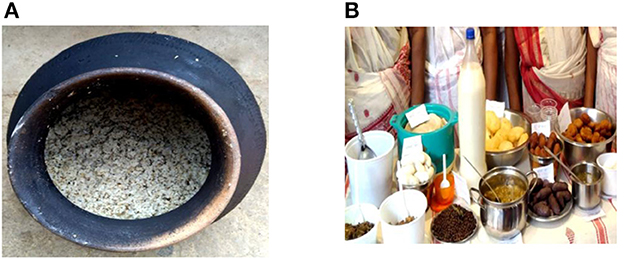
Figure 4. Fermented food: (A) Raw handia. (B) Consumable handia in a bottle with other festive foods.
Discussion
The rich knowledge of indigenous food practices among tribal communities in India highlights a wide range of cultural diversity, traditions, and environments (International Fund for Agricultural Development., 2003; Singh et al., 2007). The fascinating use of natural foods in Indian tribal communities highlights the diversity of their cultural traditions and environments. This knowledge has the potential to improve food security, nutrition, and health. Indigenous tribes hold a colossal responsibility for preserving 80% of the world's biodiversity (FAO., 2021). Their traditional food systems are important not only for cultural, social, and economic reasons but also for preserving their cuisine and way of life, as well as maintaining their cultural heritage within the community (Bhat, 2012; Durst and Bayasgalanbat, 2014). Tribal communities cultivate a variety of food crops, including a few uncommon ones. They also preserve wild foods such as mushrooms, bamboo shoots, caryota, palm pith, and so on (Rajyalakshmi, 1991). A recent study found that the Oraon community is aware of indigenous varieties of green leafy vegetables (GLVs) and consumes them during certain months or throughout the year (Ghosh-Jerath et al., 2018). Other indigenous food items from different food groups, such as cereals, roots and tubers, other vegetables, mushrooms, fruits, meat and fish, oil, and alcoholic drinks, were also reported. Fermented rice beer is a nutritious and energy-boosting beverage that is widely recognized among indigenous people worldwide but is mainly found in a few tropical Asian countries, including India. It has been reported that rice is a good source of carbohydrates (77–89%) and energy (350–475 kcal) (FAO., 1993). The fermentation process makes rice more nutritious as microbes partially digest the substrate into simple sugar and facilitate the bioavailability of lactic acid, alcohol, minerals, and bioactive compounds. Handia is a cheap, high-calorie, mild, fermented alcoholic beverage made from broken rice and consumed as a staple food by the ancestral and low-income communities of lateritic West Bengal, Assam, Bihar, Orissa, Jharkhand, and different areas of eastern and central India (Ghosh et al., 2014). Earlier studies reported that the alcohol and sugar content of raw fermentation increases with the prolongation of the fermentation time due to the presence of yeast that produces alcohol. This is achieved through the process of anaerobic fermentation, where the yeast converts simple sugars into alcohol. This increase in alcohol and sugar content is observed after the mixture has been diluted with drinking water. By the time it is consumed, the alcohol content reduces to only 2–3% (Ghosh et al., 2014, 2015). It has been well documented that the parts of plants used to prepare handia may increase the shelf-life of microbes by acting as preservatives. Moreover, the parts of the plant contain many bioactive compounds (Mallavadhani et al., 2004; Manikandan and Doss, 2010). Handia is used as a starter culture by tribal people in the tropical region, including India. Moreover, haria is a rice-based fermented beverage that is consumed as a staple food by the tribal people of central and eastern India (Ghosh et al., 2015).
There are several health benefits of the lactic acid content of handia, such as immunostimulation, cholesterol reduction, increased endocrine secretion, stress relief, and brain stimulation. It also helps protect overall intestinal function (Cory Holly Institute., 2005). In this study, the Oraon people consumed, on average, 50 ml of handia daily, which highlights the cultural significance of this traditional beverage in their community. The adult male member of the family consumes a good amount of handia before going to work. School-aged children also consume handia occasionally, primarily during festivals and marriage ceremonies. Currently, scholarly interest in rice-based fermented products is growing globally due to their high caloric value, accessibility, and widespread acceptance among the general population. Handia holds a notable cultural significance among the indigenous communities of India, who view it as an essential part of their dietary culture, survival, and maintenance of good health. The promotion of macronutrient-fortified handia may be an effective means of combating hidden hunger among adult indigenous people in India.
A recent systematic review reported that approximately 45% and 49% of men and women, respectively, in India suffered from CED (Dutta et al., 2021). The present study found an overall prevalence of CED and overweight/obesity of 39 and 7%, respectively. A previous study found that 47% of males and 30.7% of females suffer from CED (Mittal and Srivastava, 2006). Another study reported 39.2% CED among Oraon women from Jharkhand (Ghosh-Jerath et al., 2018). Another study from the Alipurduar district of West Bengal revealed that the prevalence of CED was 34.5% in men and 53.5% in women (Bhattacharya et al., 2019). The present study found the prevalence of malnutrition, as indicated by stunting and thinness, was comparatively lower among Oraon children compared to adults and children of other tribal communities in the state (Bisai et al., 2010; Das et al., 2012).
The present study highlights the considerable consumption of tubers, vegetables, and green leafy vegetables by the Oraon community. However, several factors, such as geographical limitations, limited access to agricultural technology, sociocultural practices, and community conditions, may contribute to poor nutrition and health outcomes in these communities (Bhattacharjee et al., 2009). Indigenous communities continue to face food shortages and poor diets, leading to chronic diseases (Egeland and Harrison, 2013). The lack of diversity and nutrient density in their diets has been identified as a major concern. Mittal and Srivastava (2006) reported that the diets of all Oraon tribal populations in West Bengal were deficient in all food groups, with women and children particularly vulnerable to undernourishment. The minimal consumption of milk and fruits further highlights their susceptibility to protein-energy malnutrition (Bisai and Dutta, 2021b). This lack of essential nutrients in their diets (protein, vitamins, and iron) results in poor nutritional status and a negative impact on their overall health (Gole, 2015). However, the Oraon community consumes indigenous foods that are rich sources of micronutrients, namely calcium, iron, vitamin A, and folic acid (Ghosh-Jerath et al., 2015, 2018). It has been well documented that the nutritional status of Oraon tribal adults and children in Sambalpur, Orissa, was not satisfactory, with all the children suffering from different levels of malnutrition (Beck and Mishra, 2011). Studies across the globe have suggested that there has been a shift in dietary patterns, a phenomenon known as “nutrition transition” (Popkin, 2006). In present times, many tribal communities, especially those with tourist attractions, are experiencing a shift toward westernized diets instead of their traditional diets due to the influence of modern society and the growth of “ethno-tourism” (Dutta, 2014). The shift has resulted in a significant change in the indigenous pattern of food consumption among the Oraon community due to the mixing of other communities.
In conclusion, effective intervention programs should be implemented based on regional needs. Effectively maintaining kitchen gardens and domesticating wild edible plants, seeds, tubers, and so forth may help improve nutrition. Moreover, the promotion of macronutrient-fortified rice-based beverages such as handia may be useful in combating hidden hunger among adults, as it is an indigenous beverage with high calorie content and medicinal properties.
Data availability statement
The raw data supporting the conclusions of this article will be made available by the authors, without undue reservation.
Ethics statement
The study was conducted according to ICMR guidelines and informed consent was obtained from each participant to participate in this study.
Author contributions
All authors listed have made a substantial, direct, and intellectual contribution to the work and approved it for publication.
Acknowledgments
The authors would like to thank all the studied participants. The authors would also like to thank to the authority of the Sidho-Kanho Birsha University, Cultural Research Institute, and Raiganj University for their constant support. Authors are also grateful to Ishita Biswas, Department of Microbiology, Raiganj University, Dr. Jagdeep Oraon, ATS, SKBU and Mr. Mahesh Meenz for their support.
Conflict of interest
The authors declare that the research was conducted in the absence of any commercial or financial relationships that could be construed as a potential conflict of interest.
Publisher's note
All claims expressed in this article are solely those of the authors and do not necessarily represent those of their affiliated organizations, or those of the publisher, the editors and the reviewers. Any product that may be evaluated in this article, or claim that may be made by its manufacturer, is not guaranteed or endorsed by the publisher.
Abbreviations
BMI, body mass index; CED, chronic energy deficiency; CU, consumption unit; MUAC, mid-upper arm circumference; PC, per capita; PVTGs, particularly vulnerable tribal groups; RDA, recommended dietary allowance; RDI, recommended dietary intake; and GLV, green leafy vegetable.
References
Beck, P., and Mishra, B. K. (2011). Anthropometric profile and nutritional status of selected Oraon tribals in and around Sambalpur town, Orissa. Stud. Tribes Tribals. 9, 1–9. doi: 10.1080/0972639X.2011.11886623
Bhat, S. (2012). Importance of Traditional Food System 1st Edition Chapter 2. Tumakuru: The Registrar, Tumkur University. 4–10.
Bhattacharjee, L., Kothari, G., Priya, V., and Nandi, B. K. (2009). “The Bhil food system: Links to food security, nutrition and health,” in Indigenous people's food systems: The many dimensions of culture, diversity and environment for nutrition and health, eds. H. V. Kuhnlein, B. Erasmus, D. Spigelski (Rome, Italy: FAO) 209–230.
Bhattacharya, A., Mukherjee, S., and Roy, S. K. (2019). Nutritional assessment of Oraons of West Bengal: a comparison between biochemical and anthropometric methods. Anthropol. Rev. 82, 297–311. doi: 10.2478/anre-2019-0022
Bisai, S., and Dutta, S. (2021a). “Food consumption and nutritional status of Birhor tribe of West Bengal,” in 4th International Health Sciences and Innovation Congress, Azerbaijan, Liberty Publications, USA 409–423.
Bisai, S., and Dutta, S. (2021b). “Traditional food practices of Lodha: a gathering-hunting indigenous community of West Bengal, India,” in 3rd International Conference on Food, Agriculture and Veterinary (Izmir-Turkey). 510–519.
Bisai, S., and Dutta, S. (2021c). “Food practices and nutritional status of toto community: an indigenous group of West Bengal, India,” in 1st International Marmara Scientific Research and Innovation Congress (Istanbul, Turkey, IKSAD Publishing House) 140–151.
Bisai, S., Ghosh, T., De, G. K., and Bose, K. (2010). Very high prevalence of thinness among Kora-Mudi tribal children of Paschim Medinipur District of West Bengal, India. eJ. Biol. Sci. 3, 43–49.
Bisai, S., Saha, K. B., Sharma, R. K., Muniyandi, M., and Singh, N. (2014). An overview of tribal population in India. Tribal Health Bull. 20, 1–126.
Boa, E. (2004). Wild Edible Fungi: A Global Overview of Their Use and Importance to People: Series on Nonwooden Forest Products. Rome, Italy: United Nations.
Cory Holly Institute. (2005). Lactic Acid: Friend or Foe? Available online at: www.coryholly.com/articles/article.cfm?id=35 (accessed January 2014).
Das, S., Mahata, M., and Bose, K. (2012). Age-trend in thinness among birhor children and adolescents of Purulia: a primitive tribe of West Bengal, India. Asian J. Biol. Life Sci. 1, 58–60.
DeFoliart, G. (1992). Insects as human food. Crop. Protec. 11, 395–399. doi: 10.1016/0261-2194(92)90020-6
Durst, P., and Bayasgalanbat, N. (2014). “Regional Symposium on “Promotion of underutilized indigenous food resources for food security and nutrition in Asia and the Pacific”, KhonKaen, Thailand, 31 May-2 June 2012,” in FAO Regional Office for Asia and the Pacific Maliwan Mansion>, eds. P. Durst (Thailand: FAO Regional Office for Asia and the Pacific).
Dutta, R. (2014). Concept of health, disease and treatment among the Totos of Totopara in Jalpaiguri district, West Bengal. Doctoral Thesis, Department of Anthropology. University of North Bengal.
Dutta, S., and Bisai, S. (2020). Literacy trends and differences of scheduled tribes in West Bengal: a community level analysis. Online J. Anthropol. 16, 25–32.
Dutta, S., Biswas, S., and Bisai, S. (2021). Sex variation of chronic energy deficiency. Online J. Anthropol. 17, 241–259.
Egeland, G. M., and Harrison, G. G. (2013). “Health disparities: Promoting indigenous peoples' health through traditional food systems and self-determination,” in Centre for Indigenous peoples' Nutrition and Environment (CINE), School of Dietetics and Human Nutrition, eds. G. M. Egeland (Montreal, Quebec, Canada: Food and Agriculture Organization of the United Nations (FAO)).
FAO. (1993). “Rice in human nutrition,” in FAO Food and Nutrition Series, eds. B.O. Juliano (Los Banos, Laguna, Philippines: International Rice Research Institute (IRRI)) 35–48.
FAO. (2021). The Global-hub on Indigenous Food System. Available online at: http://www.fao.org/indigenous-peoples/global-hub/en/ (accessed November 20, 2022).
Frankel, E., and Tarassuk, N. P. (1955). An extraction-titration method for the determination of free fatty acids in rancid milk and cream. J. Dairy Sci. 38, 751–763. doi: 10.3168/jds.S0022-0302(55)95036-0
Ghosh, K., Maity, C., Adak, A., Halder, S. K., Jana, A., Das, A., et al. (2014). Ethnic Preparation of Haria, a Rice-Based Fermented Beverage, in the Province of Lateritic West Bengal, India. Ethnobot. Res. Appl. 12, 039–049.
Ghosh, K., Ray, M., Adak, A., Dey, P., Halder, S. K., Das, A., et al. (2015). Microbial, saccharifying and antioxidant properties of an Indian rice based fermented beverage. Food Chem. 168, 196–202. doi: 10.1016/j.foodchem.2014.07.042
Ghosh-Jerath, S., Singh, A., Kamboj, P., Goldberg, G., and Magsumbol, M. S. (2015). Traditional knowledge and nutritive value of indigenous foods in the Oraon tribal community of Jharkhand: an exploratory cross-sectional study. Ecol. Food. Nutr. 54, 493–519. doi: 10.1080/03670244.2015.1017758
Ghosh-Jerath, S., Singh, A., Lyngdoh, T., Magsumbol, M. S., Kamboj, P., and Goldberg, G. (2018). Estimates of indigenous food consumption and their contribution to nutrient intake in Oraon tribal women of Jharkhand, India. Food Nutr. Bull. 39, 581–594. doi: 10.1177/0379572118805652
Gole, U. (2015). Nutritional status of the Oraon tribes of Jashpur District, Chhattisgarh. Int. J. Sci. Res. Pub. 5, 91–100.
Gopalan, C., Sastri, B. V. R., and Balasubramanian, S. C. (1989). Nutritive Value of Indian Foods. Hyderabad, India: National Institute of Nutrition.
International Fund for Agricultural Development. (2003). Indigenous peoples and sustainable development. United Nation: IFAD.
Kuhnlein, H. V., Erasmus, B., and Spigelski, D. (2009). Indigenous Peoples' Food Systems: The Many Dimensions of Culture, Diversity and Environment for Nutrition and Health. Rome: FAO.
Ledoux, M., and Lamy, F. (1986). Determination of proteins and sulfobetaine with the folin-phenol reagent. Anal. Biochem. 157, 28–31. doi: 10.1016/0003-2697(86)90191-0
Lohman, T. G., Roche, A. F., and Martorell, R. (1988). Anthropometric Standardization Reference Manual. Chicago, Ill, USA: Human Kinetics Books.
Lv, X., Wang, P., Wang, T., Zhao, J., and Zhang, Y. (2021). Development and validation of an improved 3-methyl-2-benzothiazolinone hydrazone method for quantitative determination of reducing sugar ends in chitooligosaccharides. Food Chem. 343, 128532. doi: 10.1016/j.foodchem.2020.128532
Mallavadhani, U. V. A, Mahapatra, K., and Jamil Reddy, P. S. (2004). Antimicrobial activity of some pentacyclictriterpenes and their synthesized 3-O-Lipophilic chains. Biol. Pharm. Bull. 27, 1576–1579. doi: 10.1248/bpb.27.1576
Manikandan, A., and Doss, D. V. A. (2010). Evaluation of biochemical contents, nutritional value, trace elements, SDSPAGE and HPTLC profiling in the leaves of Ruellia tuberosa L. and Dipteracanthus patulus (Jacq.). J. Chem. Pharm. Res. 2, 295–303.
Mittal, P. C., and Srivastava, S. (2006). Diet, nutritional status and food related traditions of Oraon tribes of New Mal (West Bengal), India. Rural Remote Health. 6, 385. doi: 10.22605/RRH385
NNMB. (2009). Diet and Nutritional Status of Tribal Population and Prevalence of Hypertension among Adults - Report on Second Repeat Survey, National Institute of Nutrition – ICMR, Hyderabad. Technical Report No, 25.
Pinstrup-Andersen, P. (2007). Agricultural research and policy for better health and nutrition in developing countries: a food systems approach. Agric. Econ. 37, 187–198. doi: 10.1111/j.1574-0862.2007.00244.x
Popkin, B. M. (2006). Global nutrition dynamics: the world is shifting rapidly toward a diet linked with noncommunicable diseases. Am. J. Clin. Nutr. 84, 289–298. doi: 10.1093/ajcn/84.2.289
Rathode, M. (2009). Nutrient content of important fruit trees from arid zone of Rajasthan. J. Hortic. Forestry. 1, 103–108.
Singh, R. K., Singh, A., and Sureja, A. K. (2007). Traditional foods of Monpa tribe of West Kameng, Arunachal Pradesh. Indian J. Tradit. Know. 6, 37–41.
Sumbhate, S. V., Nayak, S., Goupale, D., Tiwari, A., and Jadon, R. S. (2012). Colorimetric method for the estimation of ethanol in alcoholic-drinks. J. Anal. Technol. 1, 1–6.
von Grebmer, K., Saltzman, A., Birol, E., et al. (2014). Global Hunger Index: The Challenge of Hidden Hunger. Bonn, Washington, DC: Welthungerhilfe, International Food Policy Research Institute, and Concern Worldwide.
WHO. (1995). Physical Status: The Use and Interpretation of Anthropometry. Technical Report Series No. 854. Geneva: World Health Organization.
Keywords: Oraon, tribe, traditional, food, nutrition, handia, West Bengal
Citation: Bisai S, Dutta S and Das Mohapatra PK (2023) Traditional food consumption pattern and nutritional status of Oraons: An Asian Indian indigenous community. Front. Sustain. Food Syst. 7:969264. doi: 10.3389/fsufs.2023.969264
Received: 14 June 2022; Accepted: 06 February 2023;
Published: 16 March 2023.
Edited by:
Fatih Ozogul, Çukurova University, TürkiyeReviewed by:
Aida Turrini, Independent Researcher, Rome, ItalyYilmaz UÇAR, Çukurova University, Türkiye
Copyright © 2023 Bisai, Dutta and Das Mohapatra. This is an open-access article distributed under the terms of the Creative Commons Attribution License (CC BY). The use, distribution or reproduction in other forums is permitted, provided the original author(s) and the copyright owner(s) are credited and that the original publication in this journal is cited, in accordance with accepted academic practice. No use, distribution or reproduction is permitted which does not comply with these terms.
*Correspondence: Samiran Bisai, c2Jpc2FpQGhvdG1haWwuY29t
 Samiran Bisai
Samiran Bisai Sarnali Dutta
Sarnali Dutta Pradeep K. Das Mohapatra3
Pradeep K. Das Mohapatra3
